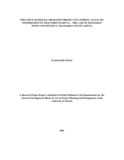| dc.description.abstract | The marvels of digital television have been presaged for more than two decades. Compared
to the old analogue technology, digital compression allows more channels to be transmitted
with better image quality and improved interactive applications. Approximately six times as
many channels can be broadcast with the same amount of transmission capacity as is
currently used for one analogue channel. The switch off of the analogue signal could result in
a large increase in the supply of television channels available to viewers or in bandwidth
being freed up for other uses. The benefits to digital broadcasting (known as digital
migration) are imperative for television and radio, hence the recommendations by
International Telecommunications Union that all countries to move to digital broadcasting by
the year 2015.While the West had already begun this process several years ago, in Africa this
issue has rarely been discussed or taken into account, getting many of their citizens off guard
come the June 17th deadline of analogue transmission. Kenya reported 1.3 million citizens no
longer able to watch television in the comfort of their homes, for various reasons. The
purpose of this study is to research on the reasons why a section of Kenyan citizens was not
able to migrate to the digital environment by assessing costs required, the monthly payments
for the new digital platform, technological preparedness of the consumer and accessibility of
various media / broadcasting stations. The research design used for the study is descriptive
survey, with special emphasis on Machakos Town Constituency. The target population is
households in the county with a sample size drawn from the 264500 households as per the
last official government census. The research employed questionnaires for data collection,
data analysis utilized the descriptive statistics and presented in frequency tables. The findings
presented showed that cost and technological preparedness of the consumer was a big setback
to the success of the Digital Migration project, and the content broadcasted needs quite a bit
revision to auger well with the viewers. However there was a notable positivity in terms of
the signal clarity from the TV stations. There is still more to be done to ensure Kenyans
benefit more from the Digital Migration in terms of costs and content. It would also be a
better income earner with better productions and more Kenyans having gainful employment
from the new broadcast platform. | en_US |



